The Word of God Holistic Wellness Institute
"Helping The World DISCOVER THE WAY of LOVE!"
Shocking News - SD Card Data Recovery Is Solved Perfectly
What Is SD Card and Its Derivatives
SD Card is short for Security Digital Card, also known as Security Digital Memory Card. It is actually a new generation of memory device based on the semiconductor flash memory device. SD card has been widely using in a variety of portable devices, including digital cameras, personal digital assistants (PDA) and multimedia players.In 1999, Panasonic put forward the concept of SD card, and Toshiba and SanDisk completed the substantive development. In 2000, these three companies finished the establishment of SD Association (Secure Digital Association, briefly called SDA), and it attracted a large number of companies to participate in this organization: IBM, Microsoft, Motorola, NEC, Samsung, and so on.
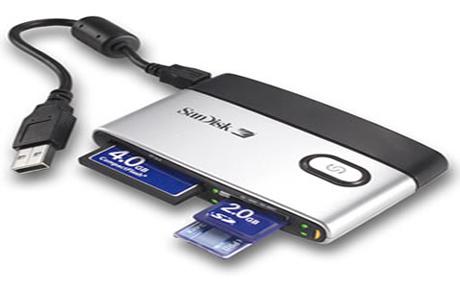
Being developed on the basis of SM card, MMC card had finally taken the place of SM card (which was developed by Toshiba) in the early 21st century. Then, based on the MMC card, SD also came out and replaced MMC card, becoming the most popular memory card format for almost all portable digital products. At that time, most digital camera manufacturers, including Canon, Nikon, Kodak, Panasonic and Konica Minolta had given support for SD card. Toshiba and SanDisk are two of the largest suppliers on the SD card market.
SD card is a multi-function memory card equipped with the features of large capacity, high performance and good security. It has a signal authentication function (SDMI specification) to protect data copyright while MMC card has no such function. What's more, the read and write speed of SD card is 4 times faster than that of MMC card and it is actually up to 2M/s.
SD card has two commonly seen derivatives; they are respectively Mini SD card and Micro SD card.
- Mini SD card: jointly developed by Panasonic and SanDisk, Mini SD card made its first appearance SanDisk booth at the 2003 CeBIT exhibition. Since then, it joined the tiny memory card specifications like Memory Stick Duo and xD cards. This card has been developed initially to cater for the increasingly popular camera phones and it can be used as general SD card through complimentary SD adapter. The capacity ranges from 16MB to 8GB.
- Micro SD card: considering the ultra-small memory card products, SD Association firstly took T-flash into its family and gives it the name of Micro SD card, which has been adopted to replace Mini SD card. The fingernail-sized Micro SD astounded consumers after its launch in 2005. And it was widely used in mobile phones in 2008.
Micro SD, together with M2 and MMC micro was known as the world's smallest mini memory card. With a ultra-small size, Micro SD card has a greater advantage: being able to be applied to various types of digital products, no waste of products' inner design space and playing a fascinating role in the refined digital lifestyle.
Speed and Capacity Levels of SD Card
SD card has different speed levels according to different data transmission speed.- "X" notation (SD1.0 specification, now abandoned): it is calculated by making the rate of CD-ROM - 150kb/s - as the benchmark. High-speed SD card can transmit at a speed of 66x (10 MB/s), 133x or higher. Some digital cameras require a high-speed SD card to make filming more smoothly and continuous photo shooting more quickly. Until December 2005, most equipment follows the SD1.01 specification. For equipment with higher speed, it follows the SD1.1 specification. The fastest speed is up to 12.5MB/s.
- In SD2.0 specification, the speed classification approach for SD card is: rate definition of ordinary card and high-speed card includes 4 levels (Class2, Class4, Class6 and Class 10). Class11 card and Class13 card remains a while before the advent of Class10 card, but ultimately, they are not adopted by SDA.
- SD3.01 specification is called super high-speed card its rate definition contains UHS-I and UHS-II. The speed level of UHS-I card is divided into UHS-Class0 and UHS-Class1 and the class of UHS-I is different from that of SD2.0. Class1 represents the maximum read speed of 104MB/s. In SD2.0 specification, class represents the minimum write speed range.
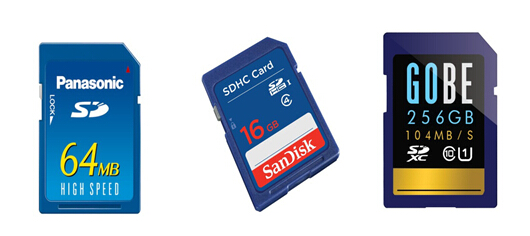
- SD: up to 2GB (8MB, 16MB, 32MB, 64MB, 128MB, 256MB, 512MB, 1GB, 2GB), FAT12 and FAT16.
- SDHC: from 2GB to 32GB (2GB, 4GB, 8GB, 16GB, 32GB), FAT32.
- SDXC: from 32GB to 2TB (32GB, 48GB, 64GB, 128GB, 256GB, 512GB, 1TB, 2TB), exFAT.
Differences between SD Card and TF Card
TF Card, short for Trans-Flash Card (which is named Micro SD card latter), has much in common with SD card. However, differences can be discovered between SD card and TF card.1.In appearance aspect
SD card: the volume is 24mm × 32mm × 2.1mm.
TF card: the volume is 15mm×11mm×1mm.
2.In name aspect
SD card stands for Secure Digital Memory Card.
TF card stands for T-Flash card or Micro SD card.
3.In origin aspect
SD card was jointly developed by the Japanese Panasonic, Toshiba and American SanDisk Corporation in August 1999.
Jointly launched by Motorola and SanDisk, TF card was the latest generation of memory card specification in 2004.
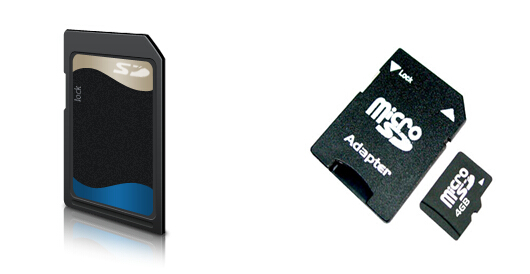
4.In definition aspect
SD card is a new generation of memory device based on semiconductor flash memory.
TF card is a small-sized flash memory card, using the latest SanDisk NAND MLC and controller technology.
5.In usage aspect
SD cards are widely used in digital cameras, personal digital assistants, multimedia players and other portable devices.
TF card is mainly used in mobile phones. However, it has been gradually applied to GPS devices, portable music players and some flash memory disks due to its small volume and increasing capacity.
6.In security aspect
There's a write protection switch on SD card, while TF card has no such part. Fortunately, a TF card can be used as a SD card by using a card holder.
7.In capacity aspect
SD card capacity includes: 128MB, 256MB, 512MB, 1GB, 2GB, 4GB, 6GB, 8GB, 16GB and 32GB.
TF card capacity includes: 128MB, 256MB, 512MB, 1GB, 2GB, 4GB, 6GB, 8GB, 16GB, 32GB and 64GB.
Data in SD Card Can't Be Modified
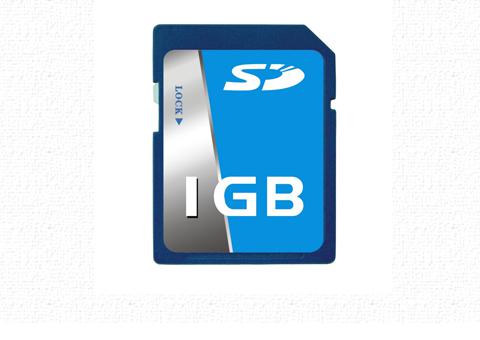
To protect data being modified deliberately, designers add a write protection switch (just as we mentioned before) to SD card. In this way, the possibility of users carrying out SD card data recovery has been greatly reduced. In fact, when users push the switch to lock the SD card, no data in the card can be modified or managed by anyone. On the contrary, those data are only in read-only state, so that users can view them trustingly and without any trouble when they are unwilling to lose them. However, when users want to change or update some SD card data, they have to push the write protection switch to the other end.
The principle of write protection switch on SD card is similar to that of write protection function in other devices, like cassette tapes, VHS tapes and computer diskettes. If accidents, such as switch damage, happen, users may not be able to turn off the write-protection function on SD card. By the way, though the vast majority of SD cards are "born" with this function, there're still some which has no such mode.
Why SD Card Is Inaccessible Sometimes
This is a common situation that troubles lots of users: the SD card is their mobile phones can't be read normally even if they have tried inserting it to phones for several times. In this case, you need to think carefully about what could be the possible causes for such phenomenon. If you still have no clue, let's show you the reasons we summarize.- SD card or phone card slot damage: if the SD card itself or the slot which is used to hold it is physically damaged, users will have no way to read any data in SD card. Because of this, users should use and place SD card in a proper way.
- Virus attack in SD card: once the SD card has been attacked by computer virus, they also can't be read as usual. What users should do at this moment is taking measures to kill the virus thoroughly.
- Wrong formatting: a user tried himself to format the SD card when he knows little about formatting work, so he tend to make mistakes during formatting. Thus, data in SD card couldn't be read. Therefore, please don't format anything in haste.
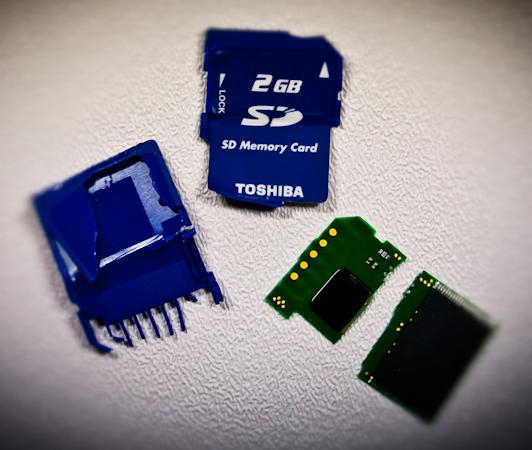
- Dust or oil stain exists on the surface of SD card: at this time, users are advised to check the color and state of the metal area in SD card to see if they are good. If dust or oil stain is found, please use cotton with alcohol/water to gently wipe the surface.
- Unstable battery voltage: the good-quality SD card often has a high requirement for power supply. So if users are using an unoriginal battery, they have to concern changing the battery for an original one.
- Wire in slot is rusted or bent over: if users take SD card out from and put it into mobile phone frequently, this situation is likely to occur. Users can try to use a needle to straighten the wire gently.
If you did a good job in avoiding above situations, you have little chance to run into SD card data loss. So you'll not be bothered by having no way to recover data from SD card.
Take Good Care of SD Card to Avoid SD Card Data Recovery
What should users do to avoid data loss in SD card? This question draws much attention of the public. We want to tell you that you're able to decrease the possibility of encountering SD data loss.First of all, put SD card in proper environment (with appropriate humidity, temperature and illumination) and be extremely carefully when you take it out from or put it back into digital devices. Secondly, try to manage SD card data on computer if it's able to do so. Thirdly, don't let strangers or the people you don't trust 100% to get access to your SD card. Surely, you've got no "chance" to experience the work to recover data from SD card if you make strict compliance with these "rules".
Recover Data after Damage Has Been Brought to SD Card
SD card can be damaged through many ways because it is relatively fragile when compared to other devices like computer hard drive. Here, we will introduce a typical case of SD card damage and the way to handle it.When you're trying to access the SD in a mobile phone, you may see a prompt pops up, saying that your SD card needs to be formatted. At this time, you should power off the mobile phone and take out the SD card in a proper way. Then, put the SD card into card reader and connect the reader to computer through USB interface. Please keep one thing in mind: whenever the computer prompts you to format SD card, you should click "Cancel". If you choose to right click SD card -> select "Properties" -> choose "Tools" -> click "Check now", you may find this process can't be executed because of SD card damage.
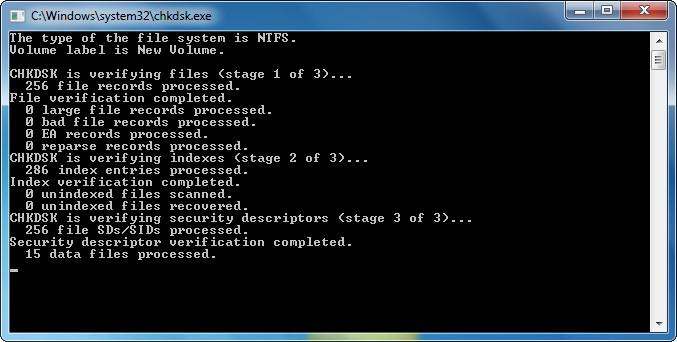
Now, you are suggested to try this way to fix the problem. Firstly, click "Start" button in the taskbar. Secondly, input "Run" to the "Search programs and files" textbox and press "Enter". Thirdly, input "chkdsk E:/F" (E: represents the drive letter of your SD card and /F represents a repair parameter) and click "OK" to start repair. Then, a window will appear to perform the task. Now, you only need to wait for the completion. When the task is over, the pop-up window will close automatically.
Now, you are only one step away to end the repair work: you should check the properties of SD card to see whether they are in normal condition or not. If they are normal, the SD card can finally be used without trouble. However, if problem still exists, you should stop any operations to it immediately and make use of a powerful SD card recovery program to get back needed data from damaged SD card. As for how to do the recovery work, you should read the detailed steps given in the following paragraphs.
A Practical and Reliable SD Card Recovery Program
To be honest, recovering data from SD card is the safest way to work out SD card damage problem. Why? It is because that any improper operations carried out after damage was found are able to bring secondary damage to data and it has bad effect on SD card data recovery, obviously. Here's a wonderful choice: MiniTool Power Data Recovery.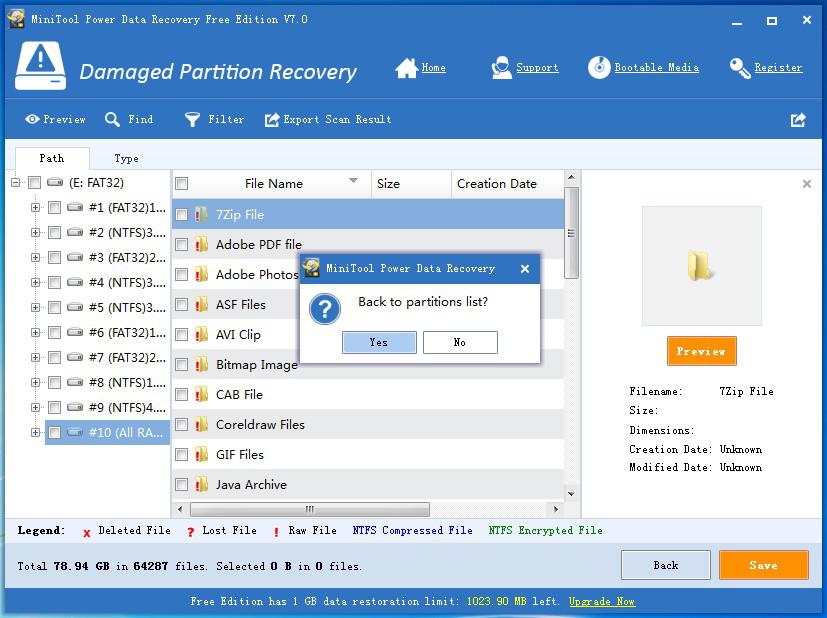
In the case that system prompts you to format SD card, you should click "Damaged Partition Recovery" function module from the main interface of MiniTool Power Data Recovery. And then, choose the partition that represents your SD card and click "Full Scan" to search for needed files. Finally, some possible partitions will be chosen and listed in software automatically. You can open those partitions one by one to find desired files carefully. If none of them contains the files you need, please press "Back" button and tap "Yes" to choose other possible partitions.
In fact, other functions of this software are also very useful. For instance, if you just need to recover some files deleted mistakenly from SD card, you should definitely choose "Undelete Recovery". As their names suggest, "Lost Partition Recovery" is suitable for recovering data from lost partition; "Digital Media Recovery" is used to recover multimedia data or recover data from digital media device; "CD/DVD Recovery" is designed especially for CD and DVD data recovery.
Don't hesitate to get MiniTool Power Data Recovery V7.0 when SD card data recovery or hard drive data recovery is needed. Definitely, it deserves your trust.
Article Source:http://www.powerdatarecovery.com/sd-card-recovery/
Views: 9
Comment
© 2024 Created by Drs Joshua and Sherilyn Smith.
Powered by
![]()

You need to be a member of The Word of God Holistic Wellness Institute to add comments!
Join The Word of God Holistic Wellness Institute